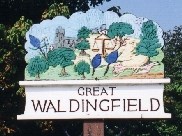Stage 1 look by the village sign and solve the following :- REPLACEMENT A E B (+) B RESULT OF F987 HURRICANE DAMAGE C BY AMPNEY CRUCIS W.I & BREDON W.I..
A+B+C+D+E+F = 32
Stage 2 is at N52 03.ABC E000 46.DEF
 GREAT WALDINGFIELD VILLAGE SIGN
GREAT WALDINGFIELD VILLAGE SIGN
Village History
Early Days
Whilst there is clear evidence of Bronze Age and Roman occupation and industry, (through the discovery of numerous items and the presence of ancient paths and roads), documentary evidence begins with the Domesday records of 1086, which listed 3 Saxon manors. The parish boundaries at that time enclosed an area of about 3,000 acres.
Until the advent of the cloth trade (in the middle of the 14th century) the area would largely have been given over to subsistence farming, raising livestock such as cattle, geese, pigs, and chickens, and growing some cereal crops.
The Middle Ages
The Peasants Revolt in 1381 and its local connections accelerated the changeover of land usage to the growing of wool, hemp and flax. This gave rise to lots of associated jobs (weaving, dying, spinning), spawning a whole cottage industry and bringing hitherto unknown wealth to the locals. The village was ideally situated between the 2 larger towns of Sudbury and Lavenham to capitalise on the boom in trade. This continued until about the middle of the 16th century, when people began buying wool from elsewhere to weave into their materials.
Records from 1522 show that 12 local people were engaged in the cloth trade. This compares with 57 in Lavenham, 28 in Melford, 27 in Sudbury and 9 in Little Waldingfield. Unfortunately tax assessments at that time (to raise money for Henry VIII) start to spell the downfall of the good times. Many of the clothmakers were upset at the taxes and determined to move out of the area. Obviously this meant jobs were lost and in 1525 there were riots in Lavenham.
In 1563 John Hopkins became the Rector and teamed up with Thomas Sternhold; together they produced the first metrical version of the Psalms, setting them to modern music. Hopkins died in 1570 and was buried in Great Waldingfield churchyard. Since then the book has run into over 600 editions and is outsold only by The Bible and The Book of Common Prayer.
Around the time of the Reformation, many of the old cottages in the village were rebuilt, adding chimneys where previously there would only have been smoke-holes. In 1559 Queen Elizabeth I tried to slow deforestation by banning the use of timber for building, and the population boom by banning the sharing of homes. This was frequently got around by turning a single cottage into 2 or 3.
The 17th century was not a good one for the village. In 1626 plague descended and numbers fell from 513 (recorded in 1611) to 459 (in 1631). The cloth trade was in serious decline, but some consolation was provided by changing the use of land from raising livestock to arable farming, allowing local people to get jobs with the farmers working the land.
It is thought that in 1648, during the siege of Colchester, Cromwell's Ironsides were billeted in the area around what is now known as Garrison Lane (perhaps for obvious reasons). Certainly, after the Civil War, groups of soldiers were stationed there for a few weeks before being disbanded.
The Church of St. Lawrence The church, dedicated to St. Lawrence, dates back to the 14th century, though there was a church on the site for some time before that - since before the Norman conquest in fact. The greatest change probably happened in 1869 after the then rector (W.D. Bailey) visited the Holy Land. In the chancel there is a mosaic of marble fragments from Rome and granite from the Holy Land. The cross is made from alabaster which came from a temple near the Sphinx.
Now, on to the cache. On the Village sign is a clue to stage 2 the final location.
* The series was started by SmokeyPugs, and I am grateful for the original idea and their encouragement in expanding the series.
If anybody would like to expand to this series please do. I would just ask that you let SmokeyPugsknow first so they can keep track of the Village Sign numbers and names to avoid duplication.